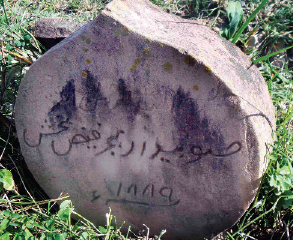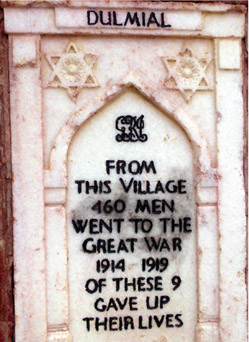
At a time when most of our villages have lost their objects of antiquity to modernism, a few still sustain their heritage and the Dulmial village of Chakwal is one of them.
Located at Kallar Kahar-Choa Saidan Shah Road, about 40km from Chakwal city, the sleepy village is famous for its martial traditions.
Since its foundation some eight centuries ago by Dolmi, a general in the Shahabuddin Ghauri’s army, the village has been providing the largest number of armymen to the state.

Some of the relics on display at the museum.
The Dulmial village sent 460 soldiers to the World War I making the largest participation of any village in South Asia while it sent 732 warriors to the World War II.
Honouring the gallantry of the 460 men, the British government awarded cannon to Dulmial which is still installed on the right bank of a pond in the village.
Besides, a memorial stone was also built in honour of the 460 soldiers on the premises of a primary school.
After the creation of Pakistan, Dulmial provided five lieutenant generals and 23 brigadiers along with many other junior officers to the army. Apart from the martial stories, Dulmial has much more to offer.

The grave of Subedar Major Faiz Bakhsh.
Graveyard
Before stepping into the village one is attracted by an old graveyard where the great men of this village have been laid to rest.
The centuries-old graveyard is dotted with old trees of Phulahi. On the graves, one can read the epitaphs of the great men of Dulmial. Capt Ghulam Mohammad Malik, who received the cannon, also rests here.
As one slides into the centre of the graveyard, they are attracted by sandstone fixed on the grave which has lost its shape.
The epitaph inscribed on the stone states the year of 1889 and bears the name of Subedar Major Faiz Bakhsh.
“Subedar Major Faiz Bakhsh was the grandfather of Iskandar Majumder, the father of Khalida Zia of Bangladesh,” says Riaz Ahmed Malik, the president of Salt Range Archaeological and Heritage Society.
“Subedar Major Sahib was posted in Bengal when he contracted a second marriage there with the grandmother of Khalida Zia’s father,” he adds.
The epitaphs at the graves of 19th century testify the literacy rate Dulmial had at that time.

A memorial built in honour of the soldiers who participated in World War I. The picture on the right is of a pre-partition house, once owned by the Hindus, in a dilapidated state. — Photos by the writer
The village pond
As one enters the village they are greeted by the pond.
The cannon installed on the right bank of the pond catches the eyesight. A pond (called Banh or Pattan in Punjabi parlance) and a tree of Banyan or Peepal on the bank was an inevitable necessity of the village life till the recent time.
The ponds not only served as the prime water reservoir for people and animals alike but they had also religious importance. As before partition Hindus and Sikhs also lived in the village they used to wash their sins at the ponds. The trees of Banyan and Peepal are also revered by the Hindus.
These ponds had also their fare share in the tales of love and romance as the lovers used to meet at these ponds.
Under the thick shadows of Banyan and Peepal trees, the villagers
used to rest beside the pond and would sing the immortal verses of Waris Shah and Mian Mohammad Bakhsh and play cards.
Unfortunately, now these ponds either have dried up or fast drying but the residents of Dulmial are committed to preserving the historic pond and the trees on its banks.
“We have constructed a wall around the pond and continue to plant saplings of different plants on its banks,” says Riaz Ahmed Malik.
The tree of Peepal on the bank of the pond has its own fascinating tale to tell. This tree, having a circumference of 150 feet and a height of 140 feet, is said to be the second largest and oldest tree in the Punjab province.
“According to a competition conducted by the Punjab forest department, this tree stood second as the first largest tree is in Narowal district,” explains Mr Malik. According to him, the tree is 800 years old.
“Our elders used to sit under this tree. They would sing Heer of Waris Shah and Saiful Malook of Mian Mohammad Bakhsh. They would discuss the village problems under this tree.”
But now this historic tree has lost its charm as it has been engulfed by the extension of a mosque carried out a few years ago. Now the tree is on the premises of the mosque.
The historic buildings
After getting into the heart of the village, one is fascinated by the buildings of the colonial era. There are two grand houses located in front of each other. According to Mr Malik, one of the houses was owned by Dr Narain Das and his brother Gobind Ram.
“Dr Narain Das was in the British Army and served during World War 1 while there is no authenticated account about Gobind Ram.”
He said the owner of the other building had also become anonymous as no one in the village knew who built the house.
Another grand building also stands in the next street which according to Mr Malik was owned by Mahesh Ram while another grand house is located in another street which was owned by Thakar Das. An old bazaar is still there.
The grand historic buildings are crumbling and need to be preserved.
Museum
Another jewel in the crown of Dulmial is its small museum where one can see scores of relics of the past.
The old shoes made of wood, memorials of first and second world wars such as a ceremonial sword, telescope, hat and scores of medals and other objects are decked in the museum.
|



